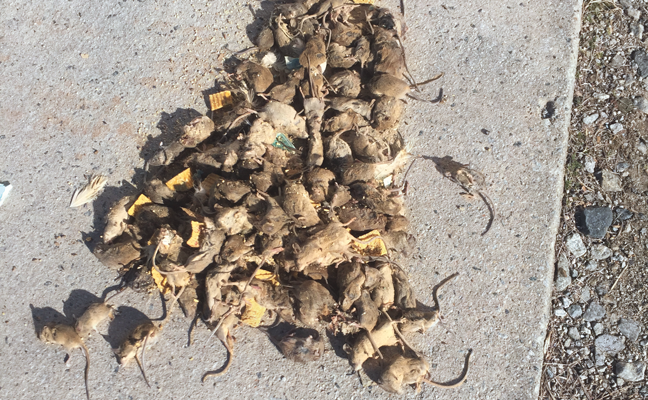
McNeely Pest Control’s three-pronged approach brought about great results. PHOTO: MCNEELY PEST CONTROL
About a year or so ago, Wayne Grush received an unusual call. The technical director of Winston-Salem, N.C.-based McNeely Pest Control was used to troubleshooting hard-to-crack accounts, but this one was a doozy: More than 3,000 field mice were infesting a poultry facility. The staff had been using retail products to try to get the population under control, with little impact. They called McNeely Pest for help, and Grush knew right away that this wasn’t going to be a one-and-done account.

Mice used chicken feathers as nesting material. PHOTO: MCNEELY PEST CONTROL
Grush and McNeely branch manager Levi Reynolds inspected the seven chicken houses, each of which was about 1,500 square feet. The units housed about 12,000 birds total. The on-site office also had mice.
“There was huge pressure outside, with nothing but fields and woods for miles around,” recalls Grush. “The feed and water were a huge draw for the mice, and the corrugated metal walls had Styrofoam insulation for excellent harborage. You could hit one wall with your fist, and a dozen mice that were burrowing inside would come running out.”
Underneath the nests was a subfloor conveyor belt to catch droppings and dropped chicken feed. It was like a basement buffet, Grush says: “You could go there anytime, day or night, and find mice running inside and outside the facilities.”
Grush and Reynolds decided that the environment was way too dusty to use glueboards, and that sanitation was already at about as high a level as one is going to get on a farm. Rodent bait and snap traps, then, would be the way to go.
“I’ve done big rodent jobs in Florida and Georgia,” notes Grush, an entomologist with many years of industry experience, “and I know the way to success on a large-scale job is to simply overwhelm them.”
The duo set a plethora of snap traps, rodent bait and liquid bait in strategic spots — out of the way of the nesting chickens, and avoiding completely the “free range” area where organic chickens resided. They stopped back twice a week for six weeks, and were picking up to 200 dead mice each visit, Grush says.
“Consumption was phenomenal,” Grush says, noting that while liquid bait is conventionally thought of as being more useful for rats than for mice, the integrated approach worked like a charm.
“It helped that we had complete cooperation from the staff,” he admits. “They made a spreadsheet and counted the dead mice on the days we weren’t there.”
Knocking down the initial population with the intense baiting and trapping program paid off, Grush says. After the first six weeks, he was able to get the account on a monthly schedule, and today only one tech is needed, trapping on average fewer than two dozen mice per visit. It’s a threshold for which the facility — and the McNeely team — is grateful.
“I like to work on challenging accounts,” Grush concludes, “but that one was pretty rough at first. Even with the mask, you breathed in a lot of feathers!”
from Pest Management Professional https://www.mypmp.net/2018/11/06/mcneely-pest-control-conquers-infestation-of-3000-mice/
Sacramento CA
No comments:
Post a Comment